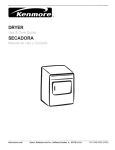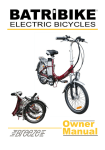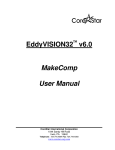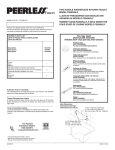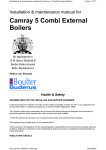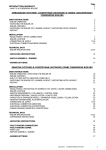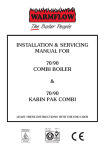Download Rayburn 200G/L Gas Fired Cooker Technical data
Transcript
PRESSURE JET CONVERSION For OIL FIRED COOKERS RAYBURN Models : OF7/G7/ 200 - 209 INSTALLATION Servicing & Commissioning ISSUE No.3 DATE: 1st September 2007 : Supplied by Snughome Cookers Ltd. 2 Cromwell Road, Shaw, Newbury, RG14 2HL Tel.No. 01635 846787 Fax. No. 01635 846787 No. - 210955 THIS IS A NEW PRODUCT SO PLEASE READ THESE INSTRUCTIONS CAREFULLY, AND IMPLEMENT THEM, DO NOT TRY AND CUT CORNERS AS THIS COULD ENDANGER THE CONSUMER. The Installation shall compliancy with : BS 5410 : Part 1 The Building Regulations BS 5449 Oil Installations up to 45 kW Part J England & Wales Part F Section III Scotland Part L Northern Ireland Part J Republic of Ireland Forced circulation hot water central heating systems for domestic installations. BS 7671 IEE Wiring Regulations 16th Edition. Installation of this Equipment must be carried out by a suitably OFTEC qualified/ trained personnel, That have also received training from Snughome in this type of conversion. GENERAL INFORMATION `This Snughome Conversion Kit for the Rayburn Cooker has been designed and manufactured by our engineers who have many year’s experience in the Conversion field and incorporates many advances in technology and design. Currently it is ideally suited to the Conversion and Refurbishment Market, where the appliance can be easily modified as required. With the steady deterioration in the quality of Domestic Fuel Oil and in order to increase the overall market, this Pressure Jet conversion has been developed in conjunction with one of the top burner manufacturers.Ltd. as these have been specifically designed for Only use components supplied by SNUGHOME this purpose. NO LIABILITY WILL BE ACCEPTED IF OTHER THAN SNUGHOME PARTS ARE FITTED. It has been designed to use most common fuel oils. All components are manufactured from wellproven materials and should give reliable service with improved economy . Noise has always been a problemwith pressure jets but in this case care has been taken to reduce this to a minimum. The sale of the Conversion is also backed up with an experienced T echnical Team that is always willing to give help and advice. This advice is also available on a Help Line. It is the Company’s policy to give the Customer and Installer the best Product and Service available. At present these instructions refer to vertically flued appliances and not low level discharge flues. Technical Data : This appliance is an oil fired pulse pressure jet 1 stage. This should give a good performance and high efficiency, and be more economic than previous vaporising burners. The Fuel suitable for this burner are as follows: 1. Class C2 Kerosene (Otherwise known as 28sec Heating Fuel.)( 1-2 mm2/sec) Low Sulphur Diesel 3. Red Diesel 4. Gas Oil Mazout 2. – ( 32 Sec Fuel).)( 2– 4.5mm2/sec) - (1.5 - 5.5 mm2/sec) (1.5 - 5.5 (8 mm2/sec) 5. mm2/sec) (A n oil Pre-heater is fitted to these burners as standard and therefore suitable for the above fuels with only a pressure change to the burner) Compliance with current legislation regarding Oil tanks and the siting thereof as directed by the Building Regulations Parts J & L. The fitting of Safety Fire Valves as directed by the Building Regulations and by Snughome Ltd. This Equipment must be earthed. This equipment should be wired from a double pole switched fused spur having a minimum contact gap of 3mm, rated at 5 amps This Equipment is only suitable for the appliance for which it has been designed.. Site Vetting; Before any decision to convert any appliance the site and the appliance must be inspected. Failure to do this will generally lead to a poor installation and a dissatisfied Customer. On arrival at the site have a look up at the chimneys and if possible check from a couple of directions. See if there is any soot stain down the sides of the chimney pots. Have a look at the surroundings of the chimney particularly angled close roofs, over hanging branches and trees, geographical position (i.e. down draught). COOKER POSITION -- Although this cooker can be turned off and on as required it should be considered as normally constant running & will get hot. Therefore it should be mounted on a solid non-combustible base and a minimum clearance of 100 mm should be left on either side of the appliance when combustible materials are placed close to it, for example kitchen units. Any other surfaces adjacent to the cooker should be of non-combustible materials. This conversion does not need free area around the sides of the cooker for air supply as it receives combustion air through the bottom of the outer door of the cooker.. Installation of this Equipment must be carried out by suitably OFTEC qualified/ trained personnel, That have also received training from Snughome in this type of conversion. 1. This is a fan assisted burner and runs at 32,000 Btu/hr 9.4 Kw maximum when burning, the air requirements for this must be taken into account when determining the necessary ventilation. 2. Extractor fans when fitted should be positioned as far away from the flue as possible and should have a sufficient dedicated air supply. To undertake a test, the oil fired appliance should be set in operation at maximum setting and the doors and windows closed. The extractor fan should then be run at its maximum setting. The oil fired heating appliance should be observed to operate satisfactorily both before and after the fan is switched on. 2. It is preferable that the air supply for the extractor fan should be located where it can serve the fan without the air stream passing close to the oil fired appliance. 3. As this appliance draws its air through the outer fire box door this must not be obstructed in any way Oil fired appliances MUST NOT draw combustion air from a garage. FLUES & CHIMNEY TERMINATION Building Regulations “J”. L1 & L2 The new approved documents J, and the “Competent Persons legislation both came into force on All installations, chimneys, flue’s , building work etc, must comply with the new legislation. Suitable Flues and liners should be used in accordance with Building Regulations Document J pages 18 - 21, and page 52 An Anti Down Draught Cowl (that conforms to British Standards) SHOULD BE FITTED. Possibly the best one on the market today is the O.H. COWL. Down draught will not go away it has to be eliminated. If the chimney is cooled by lack of insulation the difference in weight will also decrease the natural draught. The cooling of the chimney can vary a lot, amongst other things depending on the wind A bad chimney can create the following effects: 1. Pressure fluctuations at start up that create overpressure in the combustion chamber and possibly exhaust gases and soot in the room and top oven. 2. A smoky flame during the time necessary to heat the chimney until the natural draught has stabilised. 3. Deterioration of the chimney due to condensation af the water vapour into water and acid components. 4. 5. Noise and heat transferring to adjacent rooms. Soot deposits near the chimney and poor distribution of the exhaust gases due to low velocity (too cool gases in too large a chimney area. FOR SPECIALIST HELP ON CHIMNEYS OR FLUE PROBLEMS CONTACT THE O.H. HELPLINE. GOOD SOUND TECHNICAL ADVICE ON CHIMNEY’S AND FLUES CAN ALSO BE OBTAINED FROM YOUR N.A.C.S. CHIMNEY-SWEEPING TECHNICIAN OIL STORAGE & SUPPLY ( See BS5410 : Part 1 ) For this appliance the oil tank can be mounted at ground level. Also it can be fitted with the lowest oil level in the tank 1.3m below the level of the oil pump, over 1.3m a circulator or lift pump is required.The mild steel oil storage tank should be manufactured to BS 799 Part 5. Plastic oil tanks are covered by OFTEC standard OFST100. The minimum recommended oil tank size is 1400 litres (300 gallons). Codes of practice governing installation are covered by BS5410 Part 1. Should a lift pump be required with the new building regulations and current trends in health and safety it is recommended that the oil lifter is mounted external to the building. 2.. 3. 4- The pipe line MUST be of a suitable size (10 mm diameter is usually sufficient) to ensure that maximum flow can be achieved (any other appliance should be accounted for). A manual isolator valve and oil filter must be fitted directly on the outlet from the oil tank. 10 micron oil filter is fitted in control assembly to prevent small particles entering the burner assembly. Fire valves should also be fitted, one according to the instructions to protect the appliance and a second mounted external to the building to comply with the new Building Regulations. It is recommended that a manual shut off valve be fitted in the same room as the appliance. On page , a diagram of a layout is shown which would comply with the new regulations and provide a suitable oil supply to the appliance. TOOLS REQUIRED - 1. Normal fitters tools for dismantling and assembling an Aga or Rayburn. 2. Grinder or powered Sabre saw for modifying the front casting. 3. Drills for broken off bolts, ideally 1/4 & 5/16 Whitworth This guide is to help you install the Pressure Jet oil burner into an existing Rayburn 200 series cooker. It is ONLY designed to fit the models originally made for OIL or GAS operation and is NOT SUITABLE for the 4 door solid fuel variety. It may be fitted into the OF7 Regent - please ask for advice. Preparation Tools required Vacuum , hand brush ( paint brush) , bottle brush etc Sabre saw, hacksaws ( metal blade) Electric drill with drill bits to tap to 6mm ( 5.5mm bit) Metal file Fireclay – 1 kilo tub. Tube of silicone & applicator gun . Oil pipe jointing compound. Pipe bender – mini bender to bend 6/8/10mm ideal Method Remove flue pipe connections, so you can access the x frame situated between the flue “funnel” and the cast iron diverter. This is not used. Remove the cast iron hob –hotplate used to boil pans on – and the sealing rope Underneath. Remove the cast iron internal box that sits above the burner, the slag wool insulation inside it. Remove the burner, its supply pipes and the cast iron base plate it sits on .This assumes you have already disconnected the oil / gas supply to the cooker(* or have had it professionally disconnected by an approved engineer OFTEC / CORGI registered) Remove the pipe that enters the cooker through the side panel. You may leave any oil stop valve or KBB fire valve in place and any sensor inside the cooker may be simply moved out of the way. Vacuum / brush clean carefully ALL passages (remove) – above the oven and the chimney area. Ensure that the chimney is clean – get swept if necessary- and checked (see our details in this document) for soundness. Before cutting the cooker take the burner assembly and try fitting it into the cooker because in some cases it will fit without cutting the frame -- only cut if necessary. To do this, take your hacksaw, sabre saw or similar and cut through the cast iron frame as close as possible to the edge of the firebox frame. This is to allow the fan motor to enter the cooker. See photo below. I have found that a double handed hacksaw is good for this job but a sabre saw is better if more costly in blades! Battery powered sabre saw cutting cast iron frame Frame cut through, ready to break off. No damage to front casting! Once the frame is cut through – careful not to saw the enamel front- unscrew the 2 bolts located under the frame. They can easily be felt under where you have been sawing. They unscrew easily with a screwdriver about 8mm across the blade. Gently tap the frame on the inside end ( both sides) and I have found it snaps easily and cleanly . Vacuum out the area underneath to stop swarf from being sucked into the burner. Cutout removed Drilling the mounting stud holes. Fitting the mounting plate When the burner is positioned in the firebox, 2 x 6 mm studs locate it. The Burner mounting Frame, (as seen in the parts list), is used as a template. Using the frame allow 5 mm clearance above the plate. Using a felt tip or similar mark , the two mounting holes are 9 and 3 o’clock for drilling. Drill to tap to 6mm ( studs supplied) Once the holes are drilled and tapped 6 mm , screw in the studs supplied so that they just pass through the frame. Drilling the Oven to take the heat sensor Thermostat Capillary = 6 mm 150 mm You may now drill the hole to take the oven sensor. It should be drilled at a 45 degree angle about 20 mm in from the frame up into the oven. The hole will come out inside the oven, behind the side wall ( which can be unscrewed if you wish – 2 ¼” Whitworth bolts hold the side wall in place) Don’t drill too close to the frame as it makes removing the sensor more difficult . Drilling the Oven Rear Wall to mount the sensor See diagram . Drill and tap a 6 mm hole . Loosely fit the clamp, remembering to fit the small insulation pad behind the clamp. Now fit the burner frame to the burner assembly The same Frame is used for both the OF7 & OF22 burners, but the positioning is different ( See photo) Front Edge of Frame Must point forwards toward the blast tube Preparing the Burner Take a tube of silicone and apply a thick bead all around the inner face of the burner frame , Take the 35mm x 725 mm rope seal part no 1 and glue into position. Making sure that the ends both finish equal, just below the burner housing. FITTING THE CERAMICS Take the block marked No 2 and fit over the blast tube and slide tightly down onto the base. It may be necessary to gently ease the blast tube hole and the sides to allow the block to slide into position. See photo Now fit Part 3 the 50 mm x Rope Seal around the ceramic block to seal the air. It should project up the front edges as in photo. Ensure that it is pressed tightly into position Then take part No.4 the blanket with a large hole in the centre and fit into position as in photo. The 2 equal side face the oven and outer wall of the cooker. see photo. Then press the blanket outwards to fill all the gaps but try and keep the hole equal around the blast tube. The hole size can be larger to take up the fitting Position the rear insulation pad No. 5 in position as shown in photo and press in tightly coming down onto pad No.4 sealing the back. Now fit the side pad No. 6 as shown and again press tightly into position. Making sure the rear and the front corners are sealed. Now fit the front pad No. 7 as shown and again press tightly into position forcing it into the corners. The finished item should appear as shown. Fit the cast iron baffle into position with the front markings facing forward. Then place the top side insulation pad part No. 8 into position, pressing it in tightly. Now press the Top Front Insulation Pad Part No. 9 tightly into position. Press the top edges of the blankets back as far as possible so as not to restrict the air passage-ways under the hot plate. Now glue the Hot Plate 15 mm seal part No. 10 into position with the tales at the cool end of the hot plate, ensuring that it seals correctly. Glue the short 15 mm rope seal part No. 11 to the underside ridge on the hot plate. Place the hot plate into position and press down firmly. Drill a hole 15 mm into the top of the oven under the flue. Fit the 15-22 mm adaptor into the 15 mm hole and seal, then put the 22 x 300 mm pipe into the adaptor, allowing the pipe to go up the flue. Fit the flue adaptor to the top of the flue box, and seal into position, using fire clay. Then place the flue cover into position and seal. Then fit the flue to the cooker. Connecting the oil pipe. Hold the end of the 6 mm bundy tube and gently pull up and across to connect to the oil pump, using jointing compound and tightly securely. Note – because the pump is flexibly mounted make sure jointcreate is TIGHT andTrim alsoand thatbend the bundy tubeend doesn’t against whichthe would noise. the other of thereverberate pipe and make intothe thefan oil housing filter using the fitting supplied. Wiring. Connect the terminal block to the feed flex and prepare for switching on. Bleeding the oil pipe. There is a small bleed fitting on the pump- see photo- Bleeding the oil pipe. There is a small bleed fitting on the pump - see photo. 50 mm to left of oil pipe connection with thumb nut. Connect 1/8* diameter bleed tube supplied and feed into a jar. Connect oil pressure test gauge by removing knurled nut (with recessed Allen key head at top of pump) .Bleed oil through from line. Its important to bleed both sides of the pump as air can get trapped in the pump and create noise. Once bled, shut off thumb nut. Firing the burner. Advise the client you are about to fire the burner and ensure ventilation is adequate! Switch on the burner. It will take up to 4 minutes before the burner will fie from switching on, this is the time the pre-heater takes to warm up and send power to the control box. It may go to LOCK OUT initially as the oil pump is full of air. Bleed until oil is constant, note the lock out button stays RED for around 2 minutes after it locks ot. Note also that the burner is TIMED and will NOT FIRE initially until it has done its “3 minutes off cycle” .You can speed up the off period initially by switching the power off to the burner, then on again – this fools the burner into an ON period! Set pressure to 90 psi – subject to fuel type you are using. KEROSENE CLASS C2, DIESEL, RED DIESEL, Bio- Diesel, MAZOOT -- 100psi You are looking for a short blueish / yellow flame about 2-3” out of the blast tube, steady not to long or sooty. Burner air adjustment. This is obtained by moving the lever Once you are happy with the flame, fit baffle Current legislation insists that burners are set up using Combustion Testing Equipment. In order to obtain the best performance from the burner and cooker these units must also be set up using testing equipment. As there is no ideal testing point in or on the cooker it is necessary to do this in the flue above the Flue Box. Therefore drill a hole in the flue suitable for the test probe. Before firing the burner to test the combustion put a plug in the vent hole in the top oven. This is to ensure that there is no flue gas dilution due to air getting in, as this would upset any readings and give false results. Which could lead to bad combustion as the cooker gets hot. Start the burner.. After the burner has fired allow approximately 10 minutes for it to settle down. Then check the combustion. It should approximately read as follows: COLD COMBUSTION FIGURES With the cover plate in position Co --- -- -- -- 30 – 100 ppm CO2 -- -- -- -- - 8.8 – 9.0% This will change when hot Co/CO2 -- -- -- 0.0003 – 0.0008 It may be necessary to adjust the combustion to these figures by setting the air lever as detailed above. When the cooker is hot and up to temperature this should give: HOT COMBUSTION FIGURES With the cover plate in position Co --- -- -- -- 30 – 100 ppm Co/CO2 -- -- -- 0.0003 – 0.0008 If not it may be necessary to adjust accordingly. After Setting the combustion REMEMBER TO REMOVE THE PLUG FROM THE OVEN VENT or you will get condensation coming from the oven, also ensure that the combustion test hole in the flue is closed. Remember to leave the customer with the test results. Servicing. The annual service consists of the following (a) Remove burner and visually check baffles/ ceramics. Repair ceramics if required with ceramic material (we can supply) ,replace any too badly damaged. (b) Clean out burner blast area, removing any debris that may have fallen in. (c) Remove nozzle and replace with new. Check and replace blast tube if any cracking at end . (d) Remove fan unit and make sure the fan is clean – removing any build up on the blades and around the air intake. D A TE : 08/08/06 A K -0 0 3 A C C E S S O R Y P A R TS L IS T R A Y B U R N O F 7 C O N V E R S IO N . P A RT NUM B E R X0 1 -0 1 0 9 C O M P O N E N T D E S C R IP TIO N Q TY 1 / 8 " B S P T x 6 m m C o m p re s s io n E lb o w 1 6m m B undy tube x 1000m m 1 E 9 0 -3 0 3 -1 0 1 -1 0 1 -0 1 1 / 4 " B S P F ilt e r 1 X0 1 -8 0 7 -1 9 8 1 / 4 " B S P x 6 m m c o m p re s s io n c o u p lin g . 1 X0 1 -7 3 9 -2 7 5 1 / 4 " B S P x 1 0 m m c o m p re s io n c o u p lin g 3 X0 3 -S P -0 6 -0 -0 6 4 0 6 m m x 4 0 m m S tu d s 2 X0 5 -0 6 -S -W 6 m m W in g s N u t s 2 X0 4 -S P -0 6 1 2 6 m m F la t w a s h e rs 2 1 . 0 m m 3 c o re c a b le x 3 m lo n g + fe m a le 3 p in p lu g 1 E 0 3 -TF V -9 0 -3 0 TF V F IR E V A L V E x 3 m 1 E 9 0 -3 0 1 -8 0 1 -4 0 1 -0 0 6 m m x 8 0 m m b le e d t u b e . 1 E 9 0 -3 0 0 -8 0 1 -3 0 6 -0 0 . 2 5 m 6m m x 250m m bundy 1 X0 1 -2 7 7 -5 2 5 S tra ig h t e d g e c lip 1 X0 3 -S P -0 1 -1 -0 6 1 0 M 6 x 10 P oz i 1 E 9 0 -3 0 0 -8 0 1 -3 0 6 -0 0 1m DIAGRAM OF OIL LINE REQUIREMENTS IF A TOP OUTLET OIL TANK IS USED. KBB 65 SENSOR FITTED ABOVE APPLIANCE BM LIFT PUMP OR SIMILAR TO ALLOW THE OIL TO GRAVITY FEED INTO THE OIL CONTROL THE HEIGHT OF THE OIL LEVEL IN THE PUMP SHOULD BE B ETWEEN 1.5 TO 3.0 METERS ABOVE THE OIL LEVEL LINE ON THE OIL CONTROL AND SHOULD BE POSITIONED EXTERNAL TO THE BUILDING. THIS MEANS THAT IT SHOULD BE ENCLOSED IN A WEATHER-PROOF ENCLOSURE TANK ISOLATOR VALVE TOP OUTLET OIL TANK KBB 90 SENSOR OIL TANK PLINTH FILTER/STRAINER EXTERNAL FIRE VALVE KBB 65 OR SIMILAR TO COMPLY WITH PART J OF THE NEW BUILDING REGULATIONS MANUAL SHUTOFF VALVE 5/10 Micron FILTER OIL CONTROL INTERNAL FIRE VALVE KBB 90 OR SIMILAR TO PROTECT APPLIANCE FITTRD TO MANUFACTURERS INSTRUCTIONS FILTER:- A strainer/filter should be fitted to the tank. An additional 5/10 micron filter (supplied with kit) is fitted just be fore the oil control on the appliance. FIRE VALVES: - In order to comply with current legislation, a fire valve KBB 65 0r simila r Type (available from OILWARM but not supplied as part of the kit) , must be fitted at the point where the fuel line enters the property. It’s sensor being inside the property to isolate the fuel in the event of a property fire. Normally this would be si tuated above the appliance not at floor level. Under no circumstances should a KBB/E be used on this type of installation as it is self re-setting, and can allow oil to run into a hot burner. A second fire valve, KBB 90 or similar type (set at 90 oC) supplied with the kit, is fitted next to the oil control with it’s sensor located inside the burner housing


















